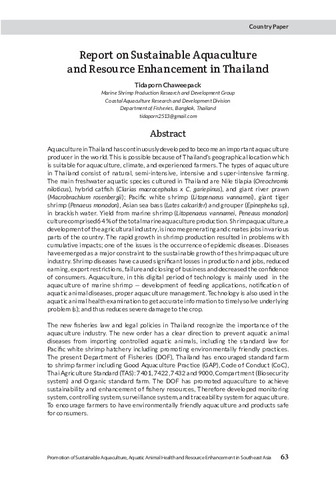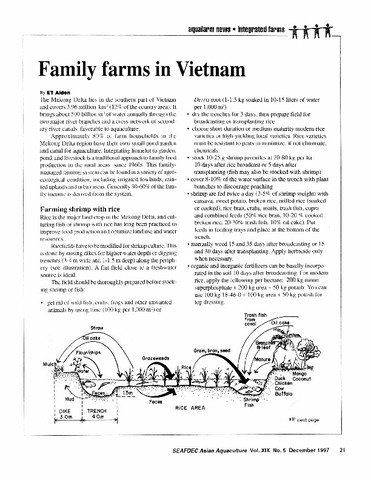Report on sustainable aquaculture and resource enhancement in Thailand
- Global styles
- MLA
- Vancouver
- Elsevier - Harvard
- APA
- Help
Share
Abstract
Aquaculture in Thailand has continuously developed to become an important aquaculture producer in the world. This is possible because of Thailand’s geographical location which is suitable for aquaculture, climate, and experienced farmers. The types of aquaculture in Thailand consist of natural, semi-intensive, intensive and super-intensive farming. The main freshwater aquatic species cultured in Thailand are Nile tilapia (Oreochromis niloticus), hybrid catfish (Clarias macrocephalus x C. gariepinus), and giant river prawn (Macrobrachium rosenbergii); Pacific white shrimp (Litopenaeus vannamei), giant tiger shrimp (Penaeus monodon), Asian sea bass (Lates calcarifer) and grouper (Epinephelus sp), in brackish water. Yield from marine shrimp (Litopenaeus vannamei, Peneaus monodon) culture comprised 64 % of the total marine aquaculture production. Shrimp aquaculture, a development of the agricultural industry, is income generating and creates jobs in various parts of the country. The rapid growth in shrimp production resulted in problems with cumulative impacts; one of the issues is the occurrence of epidemic diseases. Diseases have emerged as a major constraint to the sustainable growth of the shrimp aquaculture industry. Shrimp diseases have caused significant losses in production and jobs, reduced earning, export restrictions, failure and closing of business and decreased the confidence of consumers. Aquaculture, in this digital period of technology is mainly used in the aquaculture of marine shrimp — development of feeding applications, notification of aquatic animal diseases, proper aquaculture management. Technology is also used in the aquatic animal health examination to get accurate information to timely solve underlying problem (s); and thus reduces severe damage to the crop.
The new fisheries law and legal policies in Thailand recognize the importance of the aquaculture industry. The new order has a clear direction to prevent aquatic animal diseases from importing controlled aquatic animals, including the standard law for Pacific white shrimp hatchery including promoting environmentally friendly practices. The present Department of Fisheries (DOF), Thailand has encouraged standard farm to shrimp farmer including Good Aquaculture Practice (GAP), Code of Conduct (CoC), Thai Agriculture Standard (TAS): 7401, 7422, 7432 and 9000, Compartment (Biosecurity system) and Organic standard farm. The DOF has promoted aquaculture to achieve sustainability and enhancement of fishery resources, Therefore developed monitoring system, controlling system, surveillance system, and traceability system for aquaculture. To encourage farmers to have environmentally friendly aquaculture and products safe for consumers.
Description
Abstract only.
Suggested Citation
Chaweepack, T. (2021). Report on sustainable aquaculture and resource enhancement in Thailand. In F. A. Aya, L. D. de la Peña, N. D. Salayo, & E. A. Tendencia (Eds.), Proceedings of the International Workshop on the Promotion of Sustainable Aquaculture, Aquatic Animal Health, and Resource Enhancement in Southeast Asia (p. 63). Tigbauan, Iloilo, Philippines: Aquaculture Department, Southeast Asian Fisheries Development Center.
Type
Conference paperISBN
9789719931102 (Print); 9789719931119 (PDF)
Except where otherwise noted, this item's license is described as Attribution-NonCommercial-ShareAlike 3.0 IGO
Related items
Showing items related by title, author, creator and subject.
-
The Philippine aquaculture industry
Camacho, Arsenio S.; Macalincag-Lagua, Natividad (Aquaculture Department, Southeast Asian Fisheries Development Center, 1988)The aquaculture sector of the Philippine fishing industry registered the highest growth rate of 12.5% in 1977-1986. The contribution of aquaculture to the total fish production was equivalent to 24% in 1986 compared to ... -
Family farms in Vietnam
Aldon, Eva T. (Aquaculture Department, Southeast Asian Fisheries Development Center, 1997) -
Nursery and grow-out operation and management of Penaeus monodon (Fabricius)
Corre, Kaylin G. (Aquaculture Department, Southeast Asian Fisheries Development Center, 1988)The results of research on nursery and grow-out rearing of prawn conducted by the SEAFDEC Aquaculture Department for over a decade are reviewed. Different rearing facilities designed to accommodate hatchery-produced prawn ...







